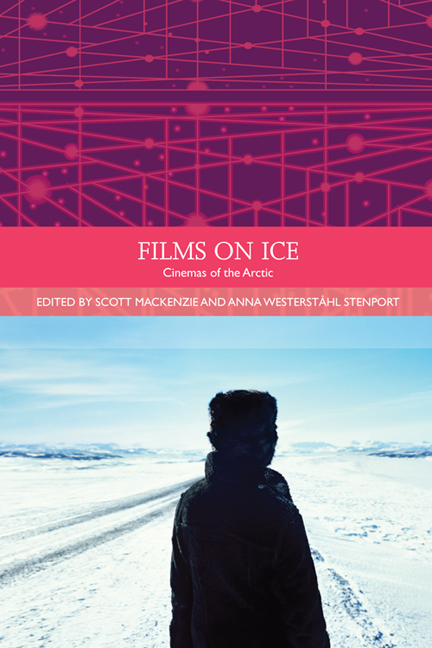Book contents
- Frontmatter
- Contents
- List of Illustrations
- Acknowledgements
- Traditions in World Cinema
- Introduction: What are Arctic Cinemas?
- PART I GLOBAL INDIGENEITY
- 1 ‘Who Were We? And What Happened to Us?’: Inuit Memory and Arctic Futures in Igloolik Isuma Film and Video
- 2 Northern Exposures and Marginal Critiques: The Politics of Sovereignty in Sámi Cinema
- 3 Frozen in Film: Alaska Eskimos in the Movies
- 4 Cultural Stereotypes and Negotiations in Sámi Cinema
- 5 Cinema of Emancipation and Zacharias Kunuk's Atanarjuat: The Fast Runner
- 6 Cosmopolitan Inuit: New Perspectives on Greenlandic Film
- 7 Arctic Carnivalesque: Ethnicity, Gender and Transnationality in the Films of Tommy Wirkola
- PART II HOLLYWOOD HEGEMONY
- PART III ETHNOGRAPHY AND THE DOCUMENTARY DILEMMA
- PART IV MYTHS AND MODES OF EXPLORATION
- Notes on the Contributors
- Index
7 - Arctic Carnivalesque: Ethnicity, Gender and Transnationality in the Films of Tommy Wirkola
from PART I - GLOBAL INDIGENEITY
Published online by Cambridge University Press: 05 September 2016
- Frontmatter
- Contents
- List of Illustrations
- Acknowledgements
- Traditions in World Cinema
- Introduction: What are Arctic Cinemas?
- PART I GLOBAL INDIGENEITY
- 1 ‘Who Were We? And What Happened to Us?’: Inuit Memory and Arctic Futures in Igloolik Isuma Film and Video
- 2 Northern Exposures and Marginal Critiques: The Politics of Sovereignty in Sámi Cinema
- 3 Frozen in Film: Alaska Eskimos in the Movies
- 4 Cultural Stereotypes and Negotiations in Sámi Cinema
- 5 Cinema of Emancipation and Zacharias Kunuk's Atanarjuat: The Fast Runner
- 6 Cosmopolitan Inuit: New Perspectives on Greenlandic Film
- 7 Arctic Carnivalesque: Ethnicity, Gender and Transnationality in the Films of Tommy Wirkola
- PART II HOLLYWOOD HEGEMONY
- PART III ETHNOGRAPHY AND THE DOCUMENTARY DILEMMA
- PART IV MYTHS AND MODES OF EXPLORATION
- Notes on the Contributors
- Index
Summary
In the last ten years, a new wave of northern Norwegian comedies have been parodying conventional images of the Arctic region. These comedies are lowbrow and carnivalesque, a cinematic continuation of a raunchy, specifically northern Norwegian oral comedy tradition. However, the parodic treatment of the Far North is entirely new to Norwegian feature film. More than ever before, these films question ethnic, gender and national identities associated with the global North. Most of the films also engage transnationally with Hollywood genre movies.
These films use genre elements associated with American movies, though these aesthetic elements are also used in movies from other countries. The use of these genre elements are new in a Norwegian context, and are most often used specifically to parody Norwegians and Norwegian culture. However, the use of elements from specific, popular American films or associated with American cinema more generally not only parodies Norwegian culture, but also the original American movies. Thus, the carnivalesque laughter in these movies is directed at both American and Norwegian culture.
At the centre of this new wave of northern Norwegian comedies is the young filmmaker Tommy Wirkola. He was born in the small northern town Alta in 1979 and is of Finnish Sámi descent. After studying media at Finnmark University College, the northernmost university college in the world, and film at Lillehammer University College, Wirkola completed a Bachelor degree in film and media at Bond University in Australia. Returning to Alta, his hometown, Wirkola produced, co-wrote and directed the feature Kill Buljo: The Movie (Norway, 2007). A low-budget Sámi parody of Quentin Tarantino's Kill Bill (2003–4), the film became a success in Norway, and launched his film career.
Tommy Wirkola's best-known Norwegian feature is Dead Snow (Død snø, Norway, 2009), a Nazi zombie film that also engages in a dialogue with American genre cinema. In 2010, Wirkola made Kurt Josef Wagle and the Legend of the Fjord Witch (Kurt Josef Wagle og legenden om fjordheksa, Norway, 2010), a parody of The Blair Witch Project (Daniel Myrick and Eduardo Sánchez, USA, 1999) set in the Far North of Norway.
- Type
- Chapter
- Information
- Films on IceCinemas of the Arctic, pp. 105 - 116Publisher: Edinburgh University PressPrint publication year: 2014

